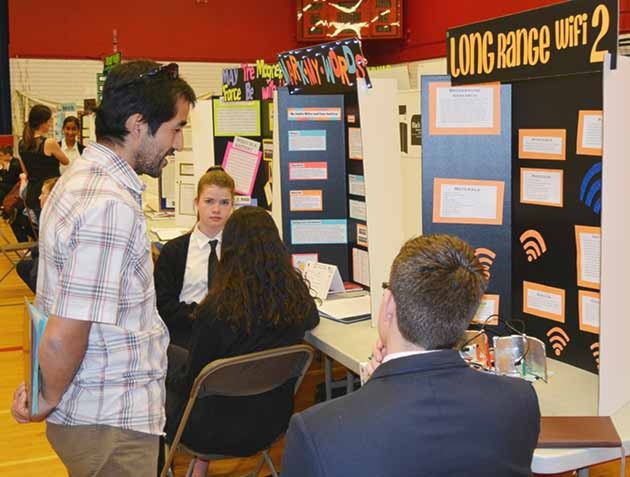When Grant Mansiere noticed that his high school, as well as others in the area, started implementing weekly programming to support students struggling with mental health issues he wanted to know what was going on.
So the Summerland Secondary School student took it upon himself to find out, and the results were on display at the regional science fair at KLO Secondary School this week.
Diving into hundreds of research papers, he mapped out a connection between altered sleep patterns, mobile phone usage and rates of depression.
The gist, he explained, is that the blue light emitted by LED lights commonly used in electronics alters circadian rhythms, putting more pressure on the systems of sleep-starved youth. That, in turn, may lead to a host of depression triggering scenarios.
���߲��о����Teenagers have to learn how they���߲��о����re quirky,���߲��о���� he said, referring to sleep patterns and how to preserve them.
While his science fair project highlighted a problem for his generation, it also made it clear he was a whiz at compiling statistics and combing through research. Mostly, however, he said he hoped those who saw his experiment took a minute to think about how their phone usage affects their well being. To help he recommended program ���߲��о����f.lux���߲��о����that inhibits blue light during the night, thereby protecting sound sleep patterns.
Mansiere wasn���߲��о����t the only person who focused their attention on the technology that every person is increasingly attached to.
There were a number of examples around KLO���߲��о����s gymnasium, Saturday.
 One that caught at least one judge���߲��о����s eye was Matthew McLaughlin���߲��о����s. The Grade 9 Aberdeen Hall student figured out a way to create long range wifi, using a parabola.
One that caught at least one judge���߲��о����s eye was Matthew McLaughlin���߲��о����s. The Grade 9 Aberdeen Hall student figured out a way to create long range wifi, using a parabola.
He came up with the idea out of necessity.
���߲��о����It was hard to get a signal in my basement,���߲��о���� he said, adding that he has no issues now.
In fact, the system he created can bring a wifi signal into the wilderness or other places people find themselves in need of a bit more bandwidth.
He expects there to be commercial uses for the parabola system he created, so he���߲��о����s still tweaking the design.
These student projects were just the tip of the iceberg at the science fair, which has been growing steadily with entrants each year, according to Shona Becker, chair of the regional science fair board and a Summerland Secondary school teacher.
There were 67 projects for students in Grade 6 to Grade 11, from school districts 67, 23 and the private schools.
Judging the work were 30 men and women pulled from area universities and colleges.
���߲��о����There are a lot of science minded kids these days,���߲��о���� said Becker.
���߲��о����With the shift in curriculum for kindergarten to Grade 9 starting next year, I think there will be more.���߲��о����
That curriculum, she said, is inquiry and science based, and is aimed at helping young people think in the future.
It���߲��о����s a positive shift considering the technology that students are surrounded in.
There were no potato batteries in the science fair this year, like their were in days of yore. And they won���߲��о����t likely make a comeback.
Students need only go to YouTube to answer any questions they have on scientific experiments. Where they step in is where the Internet stops.
���߲��о����The level of scientific inquiry we���߲��о����re starting to see is remarkable,���߲��о����said Becker.
���߲��о����We have Grade 6, 7 and 8 students researching statistics independently���߲��о����it���߲��о����s remarkable.���߲��о����



